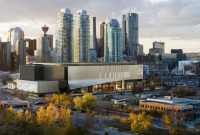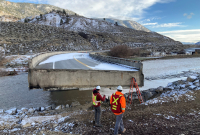Support strong Canadian climate journalism for 2025
Mike Guanella and his family were relaxing at their Colorado home and looking forward to celebrating a belated family Christmas later Thursday when reports of a nearby grass fire quickly turned into a concerning pre-evacuation notice and then within minutes into an order to leave immediately.
The Guanellas were among tens of thousands of residents who were forced to evacuate their homes outside Denver as wildfires fueled by winds that gusted up to 105 mph (169 kph) engulfed parts of two cities and burned an estimated 580 homes, a hotel and a shopping center.
Instead of opening Christmas presents at home in the city of Superior as they had planned, Guanella and his wife, their three children and three dogs were staying a friend’s house in Denver and hoping their house was still standing.
“Those presents are still under the tree right now. . . we hope,” Guanella said.
At least one first responder and six others were injured in the fires that began Thursday morning, unusually late in the year and following an extremely dry fall and a winter so far nearly devoid of snow. Boulder County Sheriff Joe Pelle acknowledged that more injuries and also deaths could be possible due to the intensity of fires that quickly swept across the region.
“This is the kind of fire we can’t fight head on,” Pelle said. “We actually had deputy sheriffs and firefighters in areas that had to pull out because they just got overrun,” he added.
As night fell, officials were watching how the winds behaved and the fires reacted to determine when crews are able to go in and begin assessing the damage and searching for any victims.
Evacuations were ordered earlier in the day for the cities of Louisville and Superior, located about 20 miles (32 kilometers) northwest of Denver and home to a combined 34,000 people. A nearby portion of U.S. Highway 36 also was shut down.
The neighboring towns are filled with middle and upper-middle class subdivisions surrounded by shopping centers, parks and schools. The area is in between Denver and Boulder, a foothills college town home to the University of Colorado.
Residents evacuated fairly calmly and orderly, but the winding streets in the subdivisions quickly became clogged as people tried to get out. It sometimes took cars as long as 45 minutes to advance about a half mile (less than a kilometer).
Small fires cropped up here and there in surprising places — on the grass in a median or in a dumpster in the middle of a parking lot — as wind gusts caused the fire to jump and spread. Shifting winds caused the skies to turn from clear to smoky and then back again as emergency sirens blared nearby.
One video captured by a bystander outside a Superior Costco store showed an apocalyptic scene with winds whipping through barren trees in the parking lot surrounded by gray skies, a hazy sun and small fires scattered across the ground.
Leah Angstman and her husband saw similar skies while returning to their Louisville home from Denver International Airport after being away for the holidays. As they were sitting on the bus going toward Boulder, Angstman recalled instantly leaving clear blue skies and entering clouds of brown and yellow smoke.
“The wind rocked the bus so hard that I thought the bus would tip,” she said.
The visibility was so poor that the bus had to pull over and they waited a half-hour until a regional transit authority van escorted them to a turnaround on the highway.
“The sky was dark, dark brown, and the dirt was blowing in swirls across the sidewalk like snakes,” she said.
Vignesh Kasinath, an assistant professor of biochemistry at the University of Colorado, evacuated from a neighborhood in Superior with his wife and her parents. Kasinath said the family was overwhelmed because of the sudden evacuation warning and anxious from the chaos while trying to leave.
“It’s only because I am active on Twitter I came to know about this,” said Kasinath, who said he did not receive an official evacuation notice from authorities.
Pelle said the first fire erupted just before 10:30 a.m. and was “attacked pretty quickly and laid down later in the day and is currently being monitored” with no structures lost.
A second wildfire, reported just after 11 a.m., “ballooned and spread rapidly east,” Pelle said. The blaze spans 2.5 square miles (6.5 square kilometers).
Some of the several blazes in the area Thursday were sparked by downed power lines.
The fires prompted Gov. Jared Polis to declare a state of a emergency, allowing the state to access disaster emergency funds.
Colorado’s Front Range, where most of the state’s population lives, had an extremely dry and mild fall, and winter so far has continued to be mostly dry. Denver set a record for most consecutive days without snow before it got a small storm on Dec. 10. It hasn’t snowed since, though snow was expected in the region Friday.
Scientists say climate change is making weather more extreme and wildfires more frequent and destructive. A historic drought and heat waves have made wildfires harder to fight in the U.S. West.
Ninety percent of Boulder County is in severe or extreme drought, and hasn’t seen substantial rainfall since mid-summer.
“With any snow on the ground, this absolutely would not have happened in the way that it did,” said snow hydrologist Keith Musselman, who was at home when Thursday's fires broke out not far away.
Musselman said this severe fire risk is expected in September and October following a dry summer, but the lack of any precipitation this late in the season is highly unusual.
The National Weather Service predicts up to a foot of snow could fall tomorrow in Boulder, and that moisture would bring substantial relief, Musselman said.
Guanella said he heard from a firefighter friend that his family's home was still standing Thursday night. And now he can only wait to see whether that holds.
“You’re just waiting to hear if your favorite restaurant is still standing, if the schools that your kids go to are still standing,” Guanella said. “You’re just waiting to get some clarity, hopefully tomorrow.”
Associated Press journalist Brittany Peterson contributed to this report. McCombs reported from Salt Lake City. Nieberg is a corps member for the Associated Press/Report for America Statehouse News Initiative. Report for America is a nonprofit national service program that places journalists in local newsrooms to report on under-covered issues.
The Associated Press receives support from the Walton Family Foundation for coverage of water and environmental policy. The AP is solely responsible for all content.




Comments